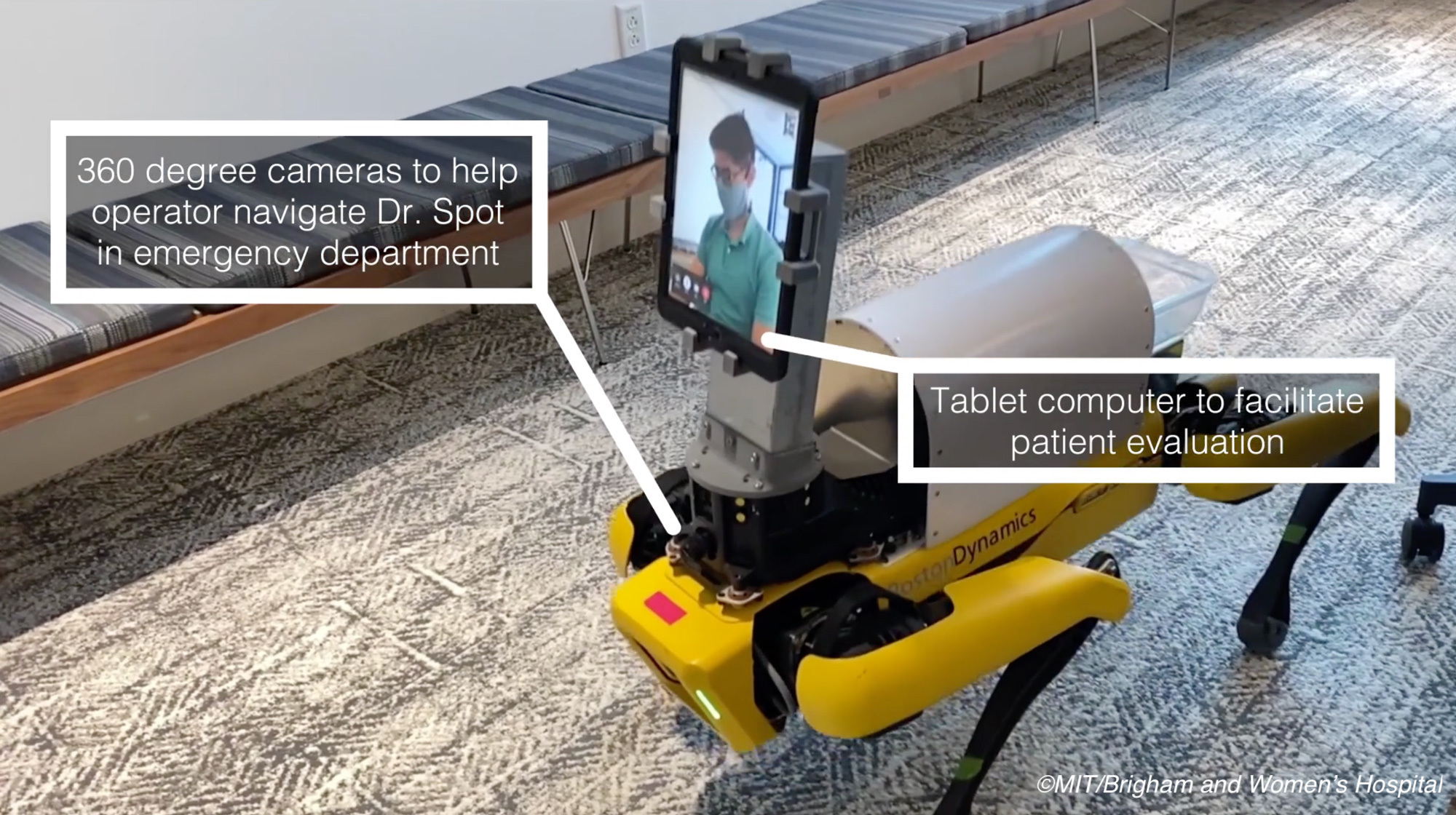During the Covid-19 pandemic, social distancing, along with masking and handwashing, have become the staples for mitigating the spread of the virus. In the healthcare setting, however, contactless care is nearly impossible.
Cue the robot
While shades of “The Terminator” might cross one’s mind, a telehealth-ready robot sporting a tablet computer with a real-time video link to a human clinician is an acceptable substitute for in-person patient triage and vital sign checks, according to a cohort study and a national survey.
“These findings suggest that using a robotic system to facilitate contactless teletriage in the ED is feasible and acceptable, with implications for public health during the Covid-19 pandemic,” wrote Peter R. Chai, MD, MMS, an assistant professor of emergency medicine at Brigham and Women’s Hospital in Boston, and colleagues in JAMA Network Open.
Chai and colleagues conducted a two-component study to determine the feasibility of using robots in a hospital setting. The first component was an assessment of patient experiences and satisfaction with in-hospital robot interactions conducted at Brigham and Women’s. The second was a national survey to query people regarding how willing they would be to have robotic interactions in the hospital. The survey expanded on the work in which the robots could be utilized beyond triage to include nasal swabbing, inserting catheters, or repositioning patients in bed.
Patient satisfaction was assessed in real-world robotic encounters with 40 middle-age patients. Most of the patients were white women, and almost two-thirds had some higher education. The study was conducted from April to August 2020.
“In total, 37 participants (92.5%) reported being satisfied with the robotic system, and 34 participants (85.0%) were also satisfied with their interaction with the clinician who used the robotic system to facilitate the interview,” Chai and colleagues reported. “A total of 38 participants (95.0%) were satisfied with the video quality of the robotic system. Despite experiencing an ED environment that can be loud and chaotic, 35 participants (87.5%) reported that the on-board audio quality was satisfactory for understanding questions and interacting with the clinician.”
Interestingly, most of the patients (82.5%) found “their robot-facilitated interaction with the clinician to be as satisfactory as a traditional in-person encounter.” The information provided was deemed understandable even though the physician was not physically present by 35 of the participants.
Would the participants be back?
Most (85%) said they found the robot care acceptable, and 92% would “be willing to interact with a robotic system in the future.”
And the survey says?
The researchers invited 3,223 people to participate in the national online survey from Aug. 18 to Aug. 21, 2020 — of these, 1,154 participants completed all questions (35% participation). “After sample matching, a nationally representative sample of 1,000 participants (mean [SD] age, 48.7 [17.0] years; 535 women [53.5%]) was included in the analysis. Similar to the in-person robotic encounter study, most of the participants (53.5%) were female; 71.9% were White; and 67.7% attended colleges or grad school.
“We selected 6 questions that reflected health care tasks with which robotic systems may assist during the Covid-19 pandemic: facilitating a telehealth interview, acquiring contactless vital signs, placing an intravenous catheter, performing phlebotomy, obtaining nasal and oral swabs, and turning a patient in bed from their back to their abdomen (i.e., proning),” Chai and colleges wrote.
A large proportion of survey respondents identified the robot as “somewhat useful” for the six categories:
- Facilitating telehealth interviews (37.3%).
- Acquiring vital signs (35.0%).
- Obtaining nasal of oral swabs (30.7%).
- Placing an intravenous catheter (22.8%).
- Performing phlebotomy (24.9%).
- Turning a patient in bed (37.1%).
Other respondents, meanwhile, found the robot to be “extremely useful”:
- Facilitating telehealth interviews (28.7%).
- Acquiring vital signs (41.3%).
- Obtaining nasal or oral swabs (19.2%).
- Placing an intravenous catheter (15.9%).
- Performing phlebotomy (16.7%).
- Turning a patient in bed (37.1%).
Chai and colleagues note that while there have been other studies looking at the use of robots in the healthcare setting, such as for rounding, there are some barriers that have been identified, “associated with technical support and unclear acceptance of these systems for use in clinical care.” Nonetheless, and even though they encountered some communication issues, “In the present cohort study, we were able to train emergency medical professionals in the operation of a robotic system and integrate the system into our existing telehealth platform to facilitate contactless triage interviews in the ED. Unlike inpatient settings, the ED setting presents distinct challenges with regard to navigating robotic systems through chaotic environments and interacting with patients in various locations.”
In the midst of a pandemic, the study authors noted that use of robotic systems could reduce Covid-19 transmission, as well as conserve personal protective equipment.
The study, however, is not without limitations. The internet survey is an opt-in survey and, despite using sample matching and weight adjustment methods, could not exclude biases. The survey respondents were predominantly White, and the in-hospital cohort were in a single-center location. And, finally, they did not collect demographic data on those who declined to participate, and thus selection bias may have been introduced.
-
A robot equipped with telehealth capabilities, as well as the ability to take vital signs, could be helpful in clinical settings to increase contactless triage and thus mitigate the spread of Covid-19 or other infectious diseases.
-
Be aware that this was a feasibility study that was conducted at a single site.
Candace Hoffmann, Managing Editor, BreakingMED™
Chai reported receiving grants from E Ink, the Hans and Mavis Lopater Psychosocial Foundation, and the National Institutes of Health (NIH) during the conduct of the study.
Cat ID: 254
Topic ID: 253,254,254,504,728,932,556,190,926,192,927,151,928,925,934


